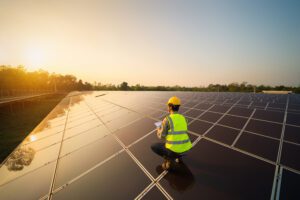Climate change is the long-term, global altering of the climate. Both regionally and globally, these shifts are possible. By “climate crisis,” one means the rise in temperature that has occurred since the mid-twentieth century. Even if there are some natural causes of climate change, human activities and greenhouse gases are the main culprits.
But luckily, sustainable solutions can reverse the effect. Unlike artificial gases, which significantly increase the amount of heat on Earth, natural greenhouse gases guarantee an adequate temperature for life. This is because they direct the heat toward the Earth instead of reflecting it into space.
The Meaning and Effect of Climate Change
Big polluting firms, who are in the majority of carbon emissions, continue to drill for and burn fossil fuels [1] despite the repercussions of the climate crisis. However, their changes become more and more visible.
Fossil fuels are profitable for various industries, including banks, automakers, and energy firms. These sectors of the economy deliberately prioritize profit over the survival of the planet and the security of its inhabitants. This needs to be changed, and get sustainable solutions on an immediate basis.
Although there are numerous greenhouse gases, the Paris Agreement regulates the following six. The following have a significant influence on climate change:
- Carbon Dioxides
- Sulfur Hexafluoride
- Nitrous Oxide
- Methane
- Perfluorocarbons
- Hydrofluorocarbons
Basic Understanding of Climate Crisis Due to Global Warming
Every year, new information regarding the effects of global warming is discovered, and we also get more proof of how disastrous it is for humans and the environment.
Communities suffer, and the number of fatalities rises as the droughts, floods, and heat waves, brought on by climate crises have become more regular and severe; this is the reason for the sudden need for sustainable solutions.
- More severe water shortages and a rise in wildfire risk will be brought on by melting glaciers, rapid snowmelt, and severe droughts.
- The coastal region, including islands, will experience increased coastal flooding due to rising sea levels.
- Cities, farms, and forests will see more problematic bugs, heat waves, torrential downpours, and flooding. Agriculture and fisheries may be harmed or destroyed by all of these.
- Many plants and animals may go extinct if environments like coral reefs and meadows are damaged.
- Increased ragweed growth, more air pollution, and the expansion of conditions that are conducive to pathogens, as well as mosquitoes, will all lead to an increase in the frequency of allergic reactions, asthma attacks, and infectious disease outbreaks.
Even though everyone is impacted by climate change and its effect, not everyone is equally affected. Usually, those who are economically underprivileged [2] are the hardest harmed.
These communities are especially susceptible to the worst effects of climate change because of imbalances built into the housing, healthcare, and labour systems.
Sustainable Solutions for Climate Crisis
Increasing the capacity of oceans and forests to retain carbon dioxide naturally can help slow the rate of global warming because both forests, as well as oceans, are crucial to controlling our climate. The major sustainable solutions for halting the climate crisis are to put pressure on businesses and governments to:
- Fossil fuels should remain underground: Coal, oil, as well as gas, is examples of fossil fuels; the more of these are mined and used, the worsening climate change will be. As quickly as possible, all nations must transition their economy away from fossil fuels.
- Spend money on green energy: The greatest solution to quit using fossil fuels is to switch to clean, renewable energy as our primary energy source. These include innovations in geothermal, tidal, and wind energy.
- Change to sustainable transportation: Fossil fuels are used in petrol and diesel automobiles, aeroplanes, and ships. Air pollution will be decreased due to cutting back on flying, moving to electric vehicles, and reducing car use.
- Boost agriculture: Reduced meat and milk consumption or turning vegan entirely are two of the best methods for people to combat climate change. To assist people in the transition, businesses, as well as food retailers, could enhance farming techniques and offer more plant-based goods.
- Restore nature to increase carbon absorption: The natural environment is excellent at removing our pollutants, but we must take care of it because photosynthesizing plants absorb carbon dioxide as they develop and store it in soils; this is the case.
- Safeguard ecosystems: Protecting forests is an effective climate solution since they are essential in the struggle against global warming. Industrial forest clearing eliminates massive trees that could absorb enormous amounts of carbon.
- Limit the use of plastics: Oil is used to make plastic, and it takes a startling amount of carbon to extract, refine, and make plastic (polyester for clothing) from oil. In addition, so much plastic is burned since it doesn’t decompose quickly in nature, which increases emissions.
It’s simple to feel overwhelmed and like the problem of the climate crisis is too huge to handle, But the solutions are already available; the challenge is putting them into practice. These sustainable solutions, especially in the most polluting industries, require effective international collaboration between governments and corporations.
Contributions to Counter Climate Change
The global response should be immediate and forceful, given the enormous disaster that the entire planet is currently experiencing. Unfortunately, however, international governments have made painfully sluggish progress. Rather there should be sustainable development but rapidly. There have been many pledges to cut carbon emissions, but few of them are legally obligatory, and goals are frequently ignored.
World leaders of 197 nations committed to prioritizing putting the needs of people above reducing greenhouse gas emissions and carbon footprint in Paris in 2015. With a goal of 1.5°C, the Paris Agreement seeks to keep global warming far below 2°C.
At Schneider Electric, we believe there is still hope of preventing the worst effects of climate change if countries move quickly to fulfil the commitments made by the Paris agreement on climate and put the solutions into place right now.



